![]()
![]()
![]()
Use LEFT and RIGHT arrow keys to navigate between flashcards;
Use UP and DOWN arrow keys to flip the card;
H to show hint;
A reads text to speech;
64 Cards in this Set
- Front
- Back
|
Three modes of selection:
|
-Directional selection favors individuals at one end of the phenotypic range
-Disruptive selection favors individuals at both extremes of the phenotypic range -Stabilizing selection favors intermediate variants and acts against extreme phenotypes |
|
|
Hardy-Weinberg
|
equation can be used to test whether a population is evolving
p+q=1 ○ 320 red flowers (CRCR) ○ _160 pink flowers (C^RC^W)______________ ○ 200 white flowers (CWCW) – Calculate the number of copies of each allele: ○ CR = (320 ´ 2) + 160 = 800 ○ CW = (20 ´ 2) + 160 = 200 – To calculate the frequency of each allele: ○ _p=freq C^R=800/(800+200)______________ ○ q = freq CW = 200 / (800 + 200) = 0.2 – The sum of alleles is always 1 0.8 + 0.2 = 1 • The Hardy-Weinberg principle describes a population that is not evolving ○ p2 + 2pq + q2 = 1 where p2 and q2 represent the frequencies of the homozygous genotypes and 2pq represents the frequency of the heterozygous genotype |
|
|
The five conditions for nonevolving populations are rarely met in nature:
|
◊ No mutations
◊ Random mating ◊ No natural selection ◊ Extremely large population size ◊ No gene flow |
|
|
Natural selection
|
-Natural selection is the only mechanism that consistently causes adaptive evolution
– Gene flow tends to reduce variation among populations over time |
|
|
Biological Species Concept
|
(one way to divide species):
-A species is a group of populations whose members can breed and produce viable, fertile offspring -Ability to mate = formation of a species -Gene flow between populations holds together the phenotype of a population (ongoing exchange of alleles) -The biological species concept emphasizes absence of gene flow |
|
|
Other Definitions of Species
|
1. morphological species concept:
-A species is characterized by its body shape -It applies to sexual and asexual species but relies on subjective criteria 2. ecological species concept: -A species is characterized by its ecological niche -It applies to sexual and asexual species and emphasizes the role of disruptive selection 3. phylogenetic species concept: -A species is the smallest group of individuals that share a common ancestor -It applies to sexual and asexual species, but it can be difficult to determine the degree of difference required for separate species |
|
|
Speciation can occur in two ways:
|
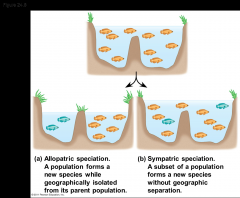
Allopatric speciation
Sympatric speciation -In a sympatric speciation, various factors can limit gene flow: -Polyploidy -Habitat differentiation -Sexual selection |
|
|
radiometric dating
|
-The absolute ages of fossils can be determined by radiometric dating
-A “parent” isotope decays to a “daughter” isotope at a constant rate -Each isotope has a known half-life, the time required for half the parent isotope to decay -Radiocarbon dating can be used to date fossils up to 75,000 years old -For older fossils, some isotopes can be used to date sedimentary rock layers above and below the fossil |
|
|
Geological record
|
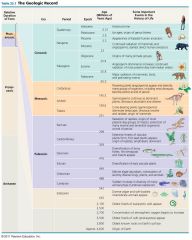
|
|
|
endosymbiont theory
|
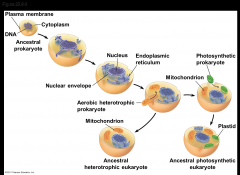
-The endosymbiont theory proposes that mitochondria and plastids (chloroplasts and related organelles) were formerly small prokaryotes living within larger host cells
-An endosymbiont is a cell that lives within a host cell |
|
|
Key evidence supporting an endosymbiotic origin of mitochondria and plastids:
|
-Inner membranes are similar to plasma membranes of prokaryotes
-Division is similar in these organelles and some prokaryotes -These organelles transcribe and translate their own DNA -Their ribosomes are more similar to prokaryotic than eukaryotic ribosomes |
|
|
Plate Tectonics
|
-At three points in time, the land masses of Earth have formed a supercontinent: 1.1 billion, 600 million, and 250 million years ago
-According to the theory of plate tectonics, Earth’s crust is composed of plates floating on Earth’s mantle -Tectonic plates move slowly through the process of continental drift -Oceanic and continental plates can collide, separate, or slide past each other -Interactions between plates cause the formation of mountains and islands, and earthquakes |
|
|
Consequences of Continental Drift
|
-Formation of the supercontinent Pangaea about 250 million years ago had many effects
--A deepening of ocean basins --A reduction in shallow water habitat --A colder and drier climate inland |
|
|
Hierarchial Classification
|
Domain, Kingdom, Phylum, Class, Order, family, genus, species
|
|
|
Alternation of Generations and Multicellular, Dependent Embryos
|
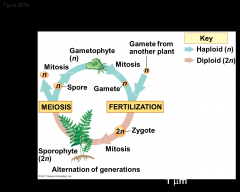
-Plants alternate between two multicellular stages, a reproductive cycle called alternation of generations
-The gametophyte is haploid and produces haploid gametes by mitosis -Fusion of the gametes gives rise to the diploid sporophyte, which produces haploid spores by meiosis -The diploid embryo is retained within the tissue of the female gametophyte -Nutrients are transferred from parent to embryo through placental transfer cells -Land plants are called embryophytes because of the dependency of the embryo on the parent |
|
|
Walled Spores Produced in Sporangia
|
-The sporophyte produces spores in organs called sporangia
-Diploid cells called sporocytes undergo meiosis to generate haploid spores -Spore walls contain sporopollenin, which makes them resistant to harsh environments |
|
|
Multicellular Gametangia
|

-Gametes are produced within organs called gametangia
-Female gametangia, called archegonia, produce eggs and are the site of fertilization -Male gametangia, called antheridia, produce and release sperm |
|
|
Apical Meristems
|
-Plants sustain continual growth in their apical meristems
-Cells from the apical meristems differentiate into various tissues |
|
|
Additional derived traits include
|
-Cuticle, a waxy covering of the epidermis
-Mycorrhizae, symbiotic associations between fungi and land plants that may have helped plants without true roots to obtain nutrients -Secondary compounds that deter herbivores and parasites |
|
|
vascular tissue
|
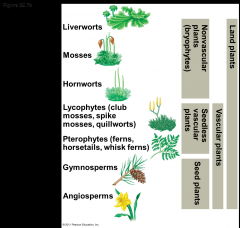
-Land plants can be informally grouped based on the presence or absence of vascular tissue
-Most plants have vascular tissue; these constitute the vascular plants -Nonvascular plants are commonly called bryophytes -Bryophytes are not a monophyletic group; their relationships to each other and to vascular plants is unresolved -Seedless vascular plants can be divided into clades -Lycophytes (club mosses and their relatives) -Pterophytes (ferns and their relatives) -Seedless vascular plants are paraphyletic, and are of the same level of biological organization, or grade |
|
|
Mosses and other nonvascular plants have life cycles dominated by gametophytes
|
-Bryophytes are represented today by three phyla of small herbaceous (nonwoody) plants
+Liverworts, phylum Hepatophyta +Hornworts, phylum Anthocerophyta +Mosses, phylum Bryophyta |
|
|
Moss Life Cycle(Gametophyte)
|
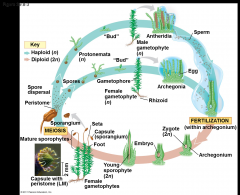
-A spore germinates into a gametophyte composed of a protonema and gamete-producing gametophore
The height of gametophytes is constrained by lack of vascular tissues -Rhizoids anchor gametophytes to substrate -Mature gametophytes produce flagellated sperm in antheridia and an egg in each archegonium -Sperm swim through a film of water to reach and fertilize the egg |
|
|
Fern Life Cycle (sporophyte)
|
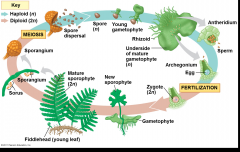
- Sporangia Release spores that develop into gametophytes
- Each gametophyte develops sperm-producing organs called antheridia and egg producing archegonia - Sperm use flagella to swim to the eggs in the archegonia - A zygote develops into a new sporophyte and grows out of the gametophyte -On the underside of the sporophyte's reproductive leaves are spots called sori. |
|
|
Five Derived Traits of Seed Plants
|

|
|
|
Plant Groups
|
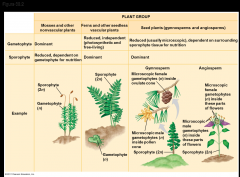
|
|
|
Flower structure
|
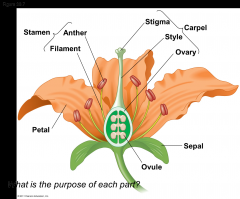
|
|
|
monocots and dicots
|

|
|
|
Embryonic development
|
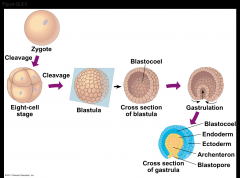
|
|
|
Symmetry
|

|
|
|
Diploblastic
|
animals have ectoderm and endoderm
-These include cnidarians and comb jellies |
|
|
Triploblastic
|
animals also have an intervening mesoderm layer; these include all bilaterians
-These include flatworms, arthropods, vertebrates, and others |
|
|
Body Cavities
|

-Most triploblastic animals possess a body cavity
-A true body cavity is called a coelom and is derived from mesoderm -Coelomates are animals that possess a true coelom -A pseudocoelom is a body cavity derived from the mesoderm and endoderm -Triploblastic animals that possess a pseudocoelom are called pseudocoelomates -Triploblastic animals that lack a body cavity are called acoelomates |
|
|
Proto vs Deuter
|

|
|
|
Most eudicots and gymnosperms have a taproot system, which consists of:
|
-A taproot, the main vertical root
-Lateral roots, or branch roots, that arise from the taproot |
|
|
Most monocots have a fibrous root system, which consists of:
|
Adventitious roots that arise from stems or leaves
Lateral roots that arise from the adventitious roots |
|
|
Root structure
|
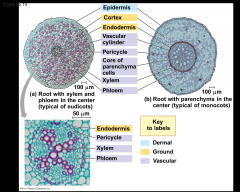
|
|
|
Stem Structure
|
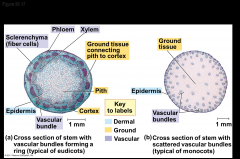
|
|
|
Pollination
|
-In angiosperms, pollination is the transfer of pollen from an anther to a stigma
-Pollination can be by wind, water, or animals -Wind-pollinated species (e.g., grasses and many trees) release large amounts of pollen |
|
|
Fruits
|
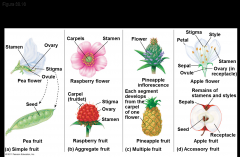
|
|
|
Exchange with the Enviornment
|
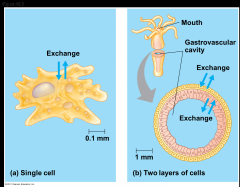
|
|
|
Feedback control maintains the internal environment in many animals
|
-A regulator uses internal control mechanisms to moderate internal change in the face of external, environmental fluctuation
-A conformer allows its internal condition to vary with certain external changes -For a given variable, fluctuations above or below a set point serve as a stimulus; these are detected by a sensor and trigger a response -The response returns the variable to the set point -The dynamic equilibrium of homeostasis is maintained by negative feedback, which helps to return a variable to a normal range -Most homeostatic control systems function by negative feedback, where buildup of the end product shuts the system off -Positive feedback amplifies a stimulus and does not usually contribute to homeostasis in animals -Homeostasis can adjust to changes in external environment, a process called acclimatization |
|
|
Homeostatic processes for thermoregulation involve form, function, and behavior
|
-Thermoregulation is the process by which animals maintain an internal temperature within a tolerable range
The body temperature of a poikilotherm varies with its environment -The body temperature of a homeotherm is relatively constant -The relationship between heat source and body temperature is not fixed (that is, not all poikilotherms are ectotherms) -Five adaptations help animals thermoregulate: =Insulation =Circulatory adaptations =Cooling by evaporative heat loss =Behavioral responses =Adjusting metabolic heat production |
|
|
countercurrent exchange
|
-Countercurrent heat exchangers transfer heat between fluids flowing in opposite directions and reduce heat loss
|
|
|
Thermogenesis
|
--the adjustment of metabolic heat production to maintain body temperature
-Thermogenesis is increased by muscle activity such as moving or shivering -Nonshivering thermogenesis takes place when hormones cause mitochondria to increase their metabolic activity -Some ectotherms can also shiver to increase body temperature -Thermoregulation is controlled by a region of the brain called the hypothalamus -The hypothalamus triggers heat loss or heat generating mechanisms -Fever is the result of a change to the set point for a biological thermostat |
|
|
Single and Double Circulation
|
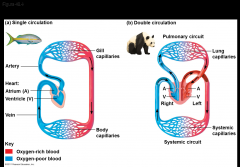
-Bony fishes, rays, and sharks have single circulation with a two-chambered heart
-In single circulation, blood leaving the heart passes through two capillary beds before returning -Amphibian, reptiles, and mammals have double circulation -Oxygen-poor and oxygen-rich blood are pumped separately from the right and left sides of the heart -In reptiles and mammals, oxygen-poor blood flows through the pulmonary circuit to pick up oxygen through the lungs -In amphibians, oxygen-poor blood flows through a pulmocutaneous circuit to pick up oxygen through the lungs and skin -Oxygen-rich blood delivers oxygen through the systemic circuit -Double circulation maintains higher blood pressure in the organs than does single circulation |
|
|
Amphibians
|
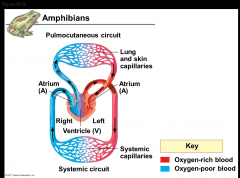
-Frogs and other amphibians have a three-chambered heart: two atria and one ventricle
-The ventricle pumps blood into a forked artery that splits the ventricle’s output into the pulmocutaneous circuit and the systemic circuit -When underwater, blood flow to the lungs is nearly shut off |
|
|
Reptiles (Except Birds)
|
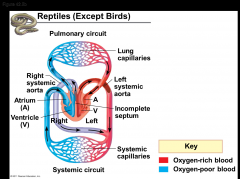
-Turtles, snakes, and lizards have a three-chambered heart: two atria and one ventricle
-In alligators, caimans, and other crocodilians a septum divides the ventricle -Reptiles have double circulation, with a pulmonary circuit (lungs) and a systemic circuit |
|
|
Mammals and Birds
|
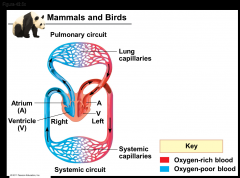
-Mammals and birds have a four-chambered heart with two atria and two ventricles
-The left side of the heart pumps and receives only oxygen-rich blood, while the right side receives and pumps only oxygen-poor blood -Mammals and birds are endotherms and require more O2 than ectotherms |
|
|
Mammalian Circulation
|
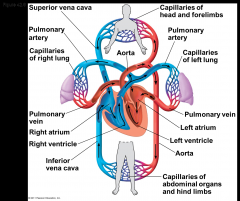
§ Right ventrical
§ Simelunar valve § Pulmonary arteries § Lungs-capillary beds-loads O2 and unloads CO2 § Pulmonary veins § Left atrium § Atrioventricular valve § Left ventrical § Semilunar valve § Aorta § Coronary arteries (to heart) § Capillary beds in head and arms § Capillary beds in the abdominal organs and legs § Capillaries rejoin, form venules, then veins § Superior vena cava § Inferior vena cava § Right atrium § Atrioventricular valve |
|
|
Fish gills use a countercurrent exchange system, where blood flows in the opposite direction to water passing over the gills; blood is always less saturated with O2 than the water it meets
|
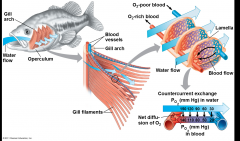
|
|
|
Respiratory system
|
-Air passes through the pharynx, larynx, trachea, bronchi, and bronchioles to the alveoli, where gas exchange occurs
-Exhaled air passes over the vocal cords in the larynx to create sounds -Cilia and mucus line the epithelium of the air ducts and move particles up to the pharynx Gas exchange takes place in alveoli, air sacs at the tips of bronchioles -Oxygen diffuses through the moist film of the epithelium and into capillaries -Carbon dioxide diffuses from the capillaries across the epithelium and into the air space |
|
|
Osmoregulation balances the uptake and loss of water and solutes
|

-Cells require a balance between uptake and loss of water
-Osmolarity, the solute concentration of a solution, determines the movement of water across a selectively permeable membrane -If two solutions are isoosmotic, the movement of water is equal in both directions -If two solutions differ in osmolarity, the net flow of water is from the hypoosmotic to the hyperosmotic solution -Osmoconformers, consisting only of some marine animals, are isoosmotic with their surroundings and do not regulate their osmolarity -Osmoregulators expend energy to control water uptake and loss in a hyperosmotic or hypoosmotic environment -Most animals are stenohaline; they cannot tolerate substantial changes in external osmolarity -Euryhaline animals can survive large fluctuations in external osmolarity |
|
|
Marine Animals
|
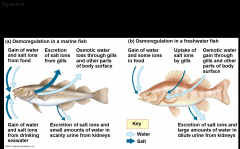
-Most marine invertebrates are osmoconformers
-Most marine vertebrates and some invertebrates are osmoregulators -Marine bony fishes are hypoosmotic to sea water -They lose water by osmosis and gain salt by diffusion and from food -They balance water loss by drinking seawater and excreting salts |
|
|
Transport Epithelia in Osmoregulation
|
-Animals regulate the solute content of body fluid that bathes their cells
-Transport epithelia are epithelial cells that are specialized for moving solutes in specific directions -They are typically arranged in complex tubular networks -An example is in nasal glands of marine birds, which remove excess sodium chloride from the blood |
|
|
The nephron is organized for stepwise processing of blood filtrate
|
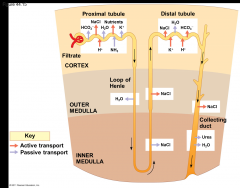
-Proximal Tubule
=Reabsorption of ions, water, and nutrients takes place in the proximal tubule =Molecules are transported actively and passively from the filtrate into the interstitial fluid and then capillaries =Some toxic materials are actively secreted into the filtrate =As the filtrate passes through the proximal tubule, materials to be excreted become concentrated -Descending Limb of the Loop of Henle =Reabsorption of water continues through channels formed by aquaporin proteins =Movement is driven by the high osmolarity of the interstitial fluid, which is hyperosmotic to the filtrate =The filtrate becomes increasingly concentrated -Ascending Limb of the Loop of Henle =In the ascending limb of the loop of Henle, salt but not water is able to diffuse from the tubule into the interstitial fluid =The filtrate becomes increasingly dilute |
|
|
Continued
|
-Distal Tubule
=The distal tubule regulates the K+ and NaCl concentrations of body fluids =The controlled movement of ions contributes to pH regulation -Collecting Duct =The collecting duct carries filtrate through the medulla to the renal pelvis =One of the most important tasks is reabsorption of solutes and water =Urine is hyperosmotic to body fluids |
|
|
The Two-Solute Model
|
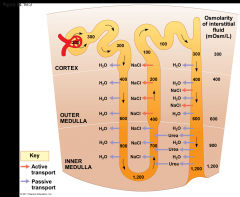
-In the proximal tubule, filtrate volume decreases, but its osmolarity remains the same
-The countercurrent multiplier system involving the loop of Henle maintains a high salt concentration in the kidney -This system allows the vasa recta to supply the kidney with nutrients, without interfering with the osmolarity gradient -Considerable energy is expended to maintain the osmotic gradient between the medulla and cortex -The collecting duct conducts filtrate through the osmolarity gradient, and more water exits the filtrate by osmosis -Urea diffuses out of the collecting duct as it traverses the inner medulla -Urea and NaCl form the osmotic gradient that enables the kidney to produce urine that is hyperosmotic to the blood |
|
|
Nerves
|
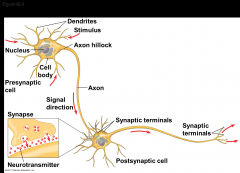
|
|
|
Action potentials are the signals conducted by axons
|
-Changes in membrane potential occur because neurons contain gated ion channels that open or close in response to stimuli
-When gated K+ channels open, K+ diffuses out, making the inside of the cell more negative -This is hyperpolarization, an increase in magnitude of the membrane potential -Opening other types of ion channels triggers a depolarization, a reduction in the magnitude of the membrane potential -For example, depolarization occurs if gated Na+ channels open and Na+ diffuses into the cell |
|
|
Graded Potentials and Action Potentials
|
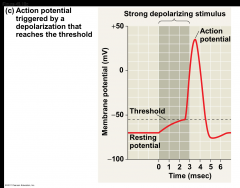
-Graded potentials are changes in polarization where the magnitude of the change varies with the strength of the stimulus
-These are not the nerve signals that travel along axons, but they do have an effect on the generation of nerve signals -If a depolarization shifts the membrane potential sufficiently, it results in a massive change in membrane voltage called an action potential -Action potentials have a constant magnitude, are all-or-none, and transmit signals over long distances They arise because some ion channels are voltage-gated, opening or closing when the membrane potential passes a certain level |
|
|
Generation of Action Potentials: A Closer Look
|
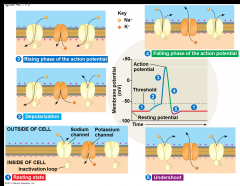
-An action potential can be considered as a series of stages
-At resting potential =1.Most voltage-gated sodium (Na+) channels are closed; most of the voltage-gated potassium (K+) channels are also closed -When an action potential is generated 2.Voltage-gated Na+ channels open first and Na+ flows into the cell 3.During the rising phase, the threshold is crossed, and the membrane potential increases 4.During the falling phase, voltage-gated Na+ channels become inactivated; voltage-gated K+ channels open, and K+ flows out of the cell 5.During the undershoot, membrane permeability to K+ is at first higher than at rest, then voltage-gated K+ channels close and resting potential is restored |
|
|
Hearing
|
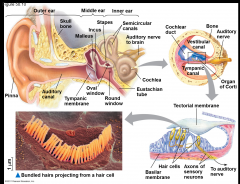
-Vibrating objects create percussion waves in the air that cause the tympanic membrane to vibrate
-The three bones of the middle ear transmit the vibrations of moving air to the oval window on the cochlea -These vibrations create pressure waves in the fluid in the cochlea that travel through the vestibular canal -Pressure waves in the canal cause the basilar membrane to vibrate, bending its hair cells -This bending of hair cells depolarizes the membranes of mechanoreceptors and sends action potentials to the brain via the auditory nerve -The fluid waves dissipate when they strike the round window at the end of the tympanic canal |
|
|
The ear conveys information about
|
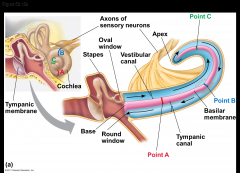
-Volume, the amplitude of the sound wave
-Pitch, the frequency of the sound wave -The cochlea can distinguish pitch because the basilar membrane is not uniform along its length -Each region of the basilar membrane is tuned to a particular vibration frequency |
|
|
Several organs of the inner ear detect body movement, position, and balance
|

-The utricle and saccule contain granules called otoliths that allow us to perceive position relative to gravity or linear movement
-Three semicircular canals contain fluid and can detect angular movement in any direction |

